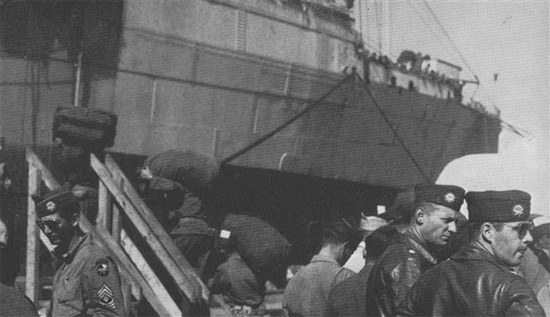-
USS Wakefield
On December 1931 was launched the Manhattan, a passenger liner built for the United States lines at Camden, NJ, by the New York Shipbuilding Co. She departed New York City on August 10, 1932 for her maiden Atlantic crossing. Arriving at Hamburg ten days later, she made the return voyage to New York in five days, fourteen hours, and twenty-eight minutes a record for passenger liners.
The Government chartered her on June 6, 1941 for a two-year period and renamed her Wakefield (AP-21). Converted to a troop transport at Brooklyn, NY, by the Robins Drydock Co, her furnishings and trappings of a luxury cruise liner were removed and stored. All of the ship’s external surfaces were painted in Navy camouflage colors and on June 15, 1941, Wakefield was commissioned, with Comdr. WN Derby, USCG in command.
On August 27, 1942, Wakefield departed the Clyde estuary, Great Britain as part of Convoy TA-18, bound for New York. While the transport was en route to her destination, on the evening of September 3, fire broke out deep within the bowels of the ship and spread rapidly. In the port column of the formation, Wakefield swung to port to run before the wind while fire fighting began immediately. On September 5, towing operations commenced, and the big transport nosed aground at McNab’s Cove, near Halifax, at 17h40 on the 8th. When fire-fighting details arrived alongside the board and commence the mammoth operation, fires still burned in three holds and in the crew’s quarters on two deck levels. Four days later, the last flames had been extinguished, and the ship was re floated on the 14th. Wakefield underwent partial repairs in Halifax harbor to prepare the vessel for her voyage to the Boston Navy Yard for complete rebuilding.
Temporarily decommissioned, the charred liner proceeded for Boston with a four-tug tow, and was declared a “constructive total loss”. The Government purchased the hulk from the United States lines and stripped the vessel to the waterline. Construction began and virtually new Wakefield arose from her ashes.
The repairs alterations began in the fall of 1942, and lasted through 1943. On February 10, 1944, the Wakefield was recommissioned at Boston, with Captain RL Raney, USCG, in command. She departed from Boston on April 13, beginning the first of twenty-three round-trips in the Atlantic theater, and three in Pacific. Between April 13, 1944 and February 1, 1946, Wakefield transported 10,563 troops to Europe and brought some 106,674 men back to America-a total of 217,237 passengers.
In many cases, Wakefield operated as a “lone wolf”, except for air coverage a few miles out of a port. Her primary port of call in European theater was Liverpool-visited so often in fact that the transport’s Crew nicknamed her “The Boston and Liverpool Ferry”. The average round-trip voyage took eighteen days.After D-day, Wakefield began the first of her trips as a casualty-evacuation ship, bringing home wounded GI’s. On occasion, she also brought back German prisoners of war for internment in the United States. After thirteen trips to Liverpool, Wakefield was sent to the Mediterranean theater to carry men and equipment on Italy and Pacific theater.

The war is finish and the boys return at home ! This famous picture shows 17th AB Division troopers during embarkment on the Wakefield, Marseille Port of Embarkation (France) on September 7, 1945 (National Archives).
Mooring at New York on May 27, 1946, Wakefield was decommissioned on June 16, five years to the day since she first entered service. Laid up in reserve, out of commission, at New York, she remained there into the 1950’s, until disposed of by Navy in 1957. After a brief tour with the National Reserve Fleet, Wakefield was struck from the Navy list in 1959 and scrapped in 1964.


